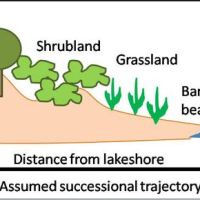Novel ecosystems Concept: Synthesis of existing currents of thoughts, and when to consider it.
Posted: May 1, 2017 Filed under: 2017, ERES525 | Tags: climate change, ecosystem management, ecosystem services, exploited species, hybrid ecosystems, invasive species, novel ecosystems 1 CommentBy Jeff Balland
The recent concept of novel ecosystems has aroused many debates. Novel ecosystems can be defined as new systems where new species combinations and functions that have never interacted historically, occur irreversibly and sustainably (Morse et al. 2014), due to anthropogenic activities, species introduction and climate change (Hobbs et al. 2006; Hobbs et al. 2009). The stage between an ecosystem and a novel ecosystem is called “hybrid ecosystem”, and can be defined by a changing system where a return to previous conditions is still possible before it reaches a tipping point (see Hobbs et al. 2013). Almost 12 years after its introduction (see also Chapin & Starfield 2005), two sides are opposed, whether restoration ecologists should integrate the concept of novel ecosystems into practice or not. I attempt to expose and criticize both of them to see what should be retained about this issue.
Embracing the concept
The proponents of this approach argue that it is more relevant to adapt to climate change, and help ecosystems to keep their functions and services when their communities are unbalanced by changing conditions. As most of existing ecosystems are concerned by changes, “novel ecosystems constitute the new normal” (Marris 2010).
As climate change affects species ranges, migrations and invasions (Parmesan 2006) and because non-indigenous species introduction is one of the biggest causes of native communities changes (natives can be excluded by losing competition) (Clavero & Garcia-Berthou 2005), promoting novel ecosystem management is to say tolerating invasive species (Rodriguez 2006). Indeed, invasive species removal has a real cost for governances. For instance, the removal costs to USA more than 22 billion dollars per year for all invasive species (Pimentel et al. 2005). Is Invasive Non-Native Species (INNS) removal compulsory? Many studies showed that sometimes, removing those species could have unexpected negative impacts on native species and ecosystems so that recovery of native species after their removal is not allowed (see Zavaleta et al. 2001; Ewel & Putz 2004): some INNS have even been described as keystone and engineer species (species playing a crucial role in the ecosystem) (Rodriguez 2006; Sousa & Gutiérrez 2009). For example, an invasive tree in Puerto Rico allows some native plants to settle where there were not able before (Lugo 2004). Considering this, exotic species should not be neglected just because they are non-native (Davis et al. 2011).

Figure 1. The Hamunara springs in New Zealand, where the Coastal Redwood is naturalized and provides useful ecosystem services in what can be considered as a a novel ecosystem. Credits: N.Y. Chan
By the way, the new concept of assisted migration (translocation of species threatened by climate change into more suitable locations), emerging as a solution to face environmental changes, will permit the creation of novel ecosystems in the areas where species are voluntary introduced (Minteer & Collins, 2010).
Finally, the novel ecosystems approach may allow improving quality of ecosystem services in exploited ecosystems such as plantation forestry or agriculture. In their study, Smaill et al.(2014) showed that the Coast Redwood Sequoia sempervirens matched all the considerations of New-Zealand foresters and could deliver better ecosystem services than the actual most exploited species (Pinus radiata). By the way, the Coastal Redwood is already naturalized in some part of the country (Figure 1).
Critiques
Yet, many scientists strongly disagree with the novel ecosystems concept. In their critique, Murcia et al.(2014) pointed several oversights of such an approach. First, assuming novel ecosystems are “the new normal” is denying successful stories of restoration and ignoring that many ecosystems are well-preserved. Secondly, it is argued that species responses to climate change are unpredictable on a local or regional scale (the usual restoration scales). Furthermore the thresholds of irreversibility in species combination, namely the tipping points determining whether a hybrid ecosystem may recover to the ancestral one or evolve toward a novel ecosystem, are still difficult if not impossible to identify (Aronson et al. 2014). According to the detractors, such a concept could provide a “license to disturb” for resource exploitation companies, and may reduce the investment in research and restoration projects because they may become unnecessary, as transformation of ecosystems may be accepted. At last, introducing or managing new species combinations, often including INNS, is not worth taking the risk and the precautionary principle should be applied to avoid any aggravation of ecosystems perturbations.
Integration in management
According to Hobbs et al.(2014), novel ecosystem approach in conservation can also be an alternative to classical restoration. In this paper, the authors made a framework on how decisions about ecosystem management should be taken (Figure 2), struggling between different limitations the managers could have in regards of management goals.

Figure 2. Framework for decision-making in ecosystem management, integrating the novel ecosystems concept. From Hobbs et al. (2014)
However, according to the authors, this framework is theoretic and crucially need further implementation. By the way, decision-making processes may be influenced by the degree of sympathy managers have towards novel ecosystems.
Conclusion
The novel ecosystem concept is a new way of looking at the environment. Integrating it in management practices may allow to use what were threats (for example invasive species) as advantages (ecosystem functioning). It may help to preserve species that are jeopardized by climate change though assisted migration, and ecosystem services of exploited lands may be enhanced by selecting species in regards of their ecological functions. In my opinion, the concept is not ignoring successful stories of restoration, nor it will provide “licence to disturb”, because novel ecosystems are not worth studying to replace conservation but to provide alternative management. However, I agree some new approaches such as assisted migration are uncertain because of unpredictable species responses (to climate change, to new community compositions, etc.). Likewise, the difficulty of identifying the tipping points in hybrid ecosystem is an obstacle to management decisions. But it is definitely worth putting energy in further investigations, because of all the knowledge about ecosystem functioning the discovery of these thresholds would bring. The concept crucially needs implementation even if the principle of precaution regarding the risks should be considered. That is why I strongly believe the concept should be embraced only as an ultimate alternative, when neither sufficient protection (reserves, protection status for species, conservation programs…) nor classical restoration can be done. In that way, the novel ecosystem approach will only provide good overcomes and exciting discoveries.
References:
Aronson, J., Murcia, C., Kattan, G.H., Moreno-Mateos, D., Dixon, K., Simberloff, D., 2014. The road to confusion is paved with novel ecosystem labels: a reply to Hobbs et al. Trends in Ecology & Evolution 29, 646–647. doi:10.1016/j.tree.2014.09.011
Murcia, C., Aronson, J., Kattan, G.H., Moreno-Mateos, D., Dixon, K., Simberloff ,D., 2014. A critique of the “novel ecosystem” concept. Trends Ecol Evol 29, 548–553. doi:10.1016/j.tree.2014.07.006
Chapin, F.S., Starfield, A.M., 1997. TIME LAGS AND NOVEL ECOSYSTEMS IN RESPONSE TO TRANSIENT CLIMATIC CHANGE IN ARCTIC ALASKA. Climatic Change 35, 449–461. doi:10.1023/A:1005337705025
Clavero, M., García-Berthou, E., 2005. Invasive species are a leading cause of animal extinctions. Trends in Ecology & Evolution 20, 110. doi:10.1016/j.tree.2005.01.003
Davis, M.A., Chew, M.K., Hobbs, R.J., Lugo, A.E., Ewel, J.J., Vermeij, G.J., Brown, J.H., Rosenzweig, M.L., Gardener, M.R., Carroll, S.P., Thompson, K., Pickett, S.T.A., Stromberg, J.C., Tredici, P.D., Suding, K.N., Ehrenfeld, J.G., Philip Grime, J., Mascaro, J., Briggs, J.C., 2011. Don’t judge species on their origins. Nature 474, 153–154. doi:10.1038/474153a
Ewel, J.J., Putz, F.E., 2004. A place for alien species in ecosystem restoration. Frontiers in Ecology and the Environment 2, 354–360. doi:10.1890/1540-9295(2004)002[0354:APFASI]2.0.CO;2
Hobbs, R.J., Arico, S., Aronson, J., Baron, J.S., Bridgewater, P., Cramer, V.A., Epstein, P.R., Ewel, J.J., Klink, C.A., Lugo, A.E., Norton, D., Ojima, D., Richardson, D.M., Sanderson, E.W., Valladares, F., Vilà, M., Zamora, R., Zobel, M., 2006. Novel ecosystems: theoretical and management aspects of the new ecological world order. Global Ecology and Biogeography 15, 1–7. doi:10.1111/j.1466-822X.2006.00212.x
Hobbs, R.J., Higgs, E., Hall, C.M., Bridgewater, P., Chapin, F.S., Ellis, E.C., Ewel, J.J., Hallett, L.M., Harris, J., Hulvey, K.B., Jackson, S.T., Kennedy, P.L., Kueffer, C., Lach, L., Lantz, T.C., Lugo, A.E., Mascaro, J., Murphy, S.D., Nelson, C.R., Perring, M.P., Richardson, D.M., Seastedt, T.R., Standish, R.J., Starzomski, B.M., Suding, K.N., Tognetti, P.M., Yakob, L., Yung, L., 2014. Managing the whole landscape: historical, hybrid, and novel ecosystems. Frontiers in Ecology and the Environment 12, 557–564. doi:10.1890/130300
Hobbs, R.J., Higgs, E., Harris, J.A., 2009. Novel ecosystems: implications for conservation and restoration. Trends in Ecology & Evolution 24, 599–605. doi:10.1016/j.tree.2009.05.012
Hobbs, R.J., Higgs, E.S., Harris, J.A., 2014. Novel ecosystems: concept or inconvenient reality? A response to Murcia et al. Trends in Ecology & Evolution 29, 645–646. doi:10.1016/j.tree.2014.09.006
Lugo, A.E., 2004. The outcome of alien tree invasions in Puerto Rico. Frontiers in Ecology and the Environment 2, 265–273. doi:10.1890/1540-9295(2004)002[0265:TOOATI]2.0.CO;2
Marris, E., 2006. Ecological and Evolutionary Responses to Recent Climate Change. Annual Review of Ecology, Evolution, and Systematics 37, 637–669. doi:10.1146/annurev.ecolsys.37.091305.110100
Marris, E., 2010. The new normal. Conserv. Mag. 11, 13–17
Morse, N.B., Pellissier, P.A., Cianciola, E.N., Brereton, R.L., Sullivan, M.M., Shonka, N.K., Wheeler, T.B., McDowell, W.H., 2014. Novel ecosystems in the Anthropocene: a revision of the novel ecosystem concept for pragmatic applications. Ecology & Society 19, 85–94. doi:10.5751/ES-06192-190212
Pimentel, D., Zuniga, R., Morrison, D., 2005. Update on the environmental and economic costs associated with alien-invasive species in the United States. Ecological Economics, Integrating Ecology and Economics in Control BioinvasionsIEECB S.I. 52, 273–288. doi:10.1016/j.ecolecon.2004.10.002
Smaill, S.J., Bayne, K.M., Coker, G.W.R., Paul, T.S.H., Clinton, P.W., 2014. The Right Tree for the Job? Perceptions of Species Suitability for the Provision of Ecosystem Services. Environmental Management 53, 783–799. doi:10.1007/s00267-014-0239-5
Sousa, R., Gutiérrez, J.L., Aldridge, D.C., 2009. Non-indigenous invasive bivalves as ecosystem engineers. Biol Invasions 11, 2367–2385. doi:10.1007/s10530-009-9422-7
Truitt, A.M., Granek, E.F., Duveneck, M.J., Goldsmith, K.A., Jordan, M.P., Yazzie, K.C., 2015. What is Novel About Novel Ecosystems: Managing Change in an Ever-Changing World. Environmental Management 55, 1217–1226. doi:10.1007/s00267-015-0465-5




Reblogged this on Green Living 4 Live.
LikeLike